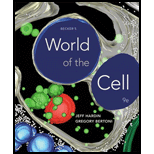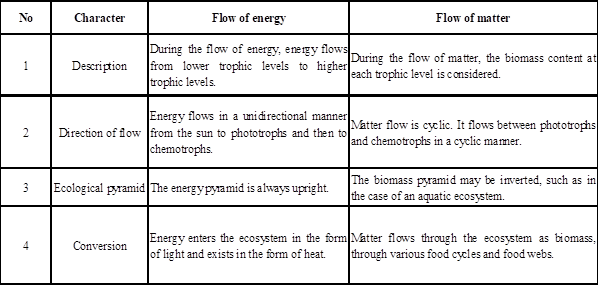
Concept explainers
How do phototrophs and chemotrophs depend intimately on each other? How does the flow of energy differ from the flow of matter?
To determine: How phototrophs and chemotrophs depend intimately on each other.
Introduction: All organisms derive their energy from the sunlight through direct or indirect methods. Phototrophs and chemotrophs are classified depending on the sources from which they derive their energy.
Explanation of Solution
Phototrophs are organisms which derive their energy directly from the sun. They have pigments that can absorb light. This light energy is converted to chemical energy and stored in the form of the energy currency of the cell that is ATP. Chemotrophs are organisms that derive their energy from the oxidation of electron donors in organic and inorganic molecules and use it for their processes. Following are the ways in which phototrophs and chemotrophs depend on each other:
- When light energy is not available, photoautotrophs need to act as chemotrophs so that they can continue to obtain energy.
- Even for the parts of the plant which are not exposed to the sunlight, their function as chemotrophs is necessary. Hence, most plants have both phototrophic as well as chemotrophic cells.
- Another way in which phototrophs depend on chemotrophs is that phototrophs need carbon sources other than carbon dioxide. They obtain these from chemotrophic organisms such as purple non-sulfur bacteria and green non-sulfur bacteria.
- Chemoheterotrophs are unable to produce their own food and thus they require food produced from phototrophs.
Thus, phototrophs and chemotrophs depend intimately on each other.
To determine: How the flow of energy differs from the flow of matter.
Introduction: All organisms derive their energy from the sunlight through direct or indirect methods. Phototrophs and chemotrophs are classified depending on the sources from which they derive their energy. The energy and mass flows through the ecosystem in a balanced way.
Explanation of Solution
The flow of energy differs from the flow of matter in following ways:

Phototrophs capture the light energy and convert it into chemical energy. This is them cycled throughout the system and gets converted into various forms. Photosynthesis and respiration are means by which energy flows through the different cycles. Finally, energy leaves a food chain in the form of heat. The organic matter produced by plants serves as the primary biomass for heterotrophs. This is how the flow of matter occurs in the ecosystem. The cycle is complete by decomposers, which convert organic biomass back into inorganic form.
Thus, the flow of energy and the flow of matter are interconnected and manage how mass and energy flows through different food cycles and trophic levels of the ecosystem.
Want to see more full solutions like this?
Chapter 5 Solutions
Becker's World of the Cell (9th Edition)
- Every tutor here has got this wrong, don't copy off them.arrow_forwardSuppose that the population from question #1 (data is in table below) is experiencing inbreeding depression (F=.25) (and no longer experiencing natural selection). Calculate the new expected genotype frequencies (f) in this population after one round of inbreeding. Please round to 3 decimal places. Genotype Adh Adh Number of Flies 595 Adh Adh 310 Adhs Adhs 95 Total 1000 fladh Adh- flAdn Adh fAdhs Adharrow_forwardWhich of the following best describes why it is difficult to develop antiviral drugs? Explain why. A. antiviral drugs are very difficult to develop andhave no side effects B. viruses are difficult to target because they usethe host cell’s enzymes and ribosomes tometabolize and replicate C. viruses are too small to be targeted by drugs D. viral infections usually clear up on their ownwith no problemsarrow_forward
- This question has 3 parts (A, B, & C), and is under the subject of Nutrition. Thank you!arrow_forwardThey got this question wrong the 2 previous times I uploaded it here, please make sure it's correvct this time.arrow_forwardThis question has multiple parts (A, B & C), and under the subject of Nutrition. Thank you!arrow_forward
- Calculate the CFU/ml of a urine sample if 138 E. coli colonies were counted on a Nutrient Agar Plate when0.5 mls were plated on the NA plate from a 10-9 dilution tube. You must highlight and express your answerin scientific notatioarrow_forwardDon't copy off the other answer if there is anyarrow_forwardAnswerarrow_forward
- HAND DRAW There should be two proarrow_forwardMolecular Biology Question. Please help solve. Thanks. Please draw how two nucleotide triphosphates are linked together to form a dinucleotide, and label the 5' and 3' ends of the resulting dinucleotide.arrow_forwardWhat is a reversion in molecular biology?arrow_forward
 Biology 2eBiologyISBN:9781947172517Author:Matthew Douglas, Jung Choi, Mary Ann ClarkPublisher:OpenStax
Biology 2eBiologyISBN:9781947172517Author:Matthew Douglas, Jung Choi, Mary Ann ClarkPublisher:OpenStax Biology Today and Tomorrow without Physiology (Mi...BiologyISBN:9781305117396Author:Cecie Starr, Christine Evers, Lisa StarrPublisher:Cengage Learning
Biology Today and Tomorrow without Physiology (Mi...BiologyISBN:9781305117396Author:Cecie Starr, Christine Evers, Lisa StarrPublisher:Cengage Learning Concepts of BiologyBiologyISBN:9781938168116Author:Samantha Fowler, Rebecca Roush, James WisePublisher:OpenStax College
Concepts of BiologyBiologyISBN:9781938168116Author:Samantha Fowler, Rebecca Roush, James WisePublisher:OpenStax College Principles Of Radiographic Imaging: An Art And A ...Health & NutritionISBN:9781337711067Author:Richard R. Carlton, Arlene M. Adler, Vesna BalacPublisher:Cengage Learning
Principles Of Radiographic Imaging: An Art And A ...Health & NutritionISBN:9781337711067Author:Richard R. Carlton, Arlene M. Adler, Vesna BalacPublisher:Cengage Learning Biology (MindTap Course List)BiologyISBN:9781337392938Author:Eldra Solomon, Charles Martin, Diana W. Martin, Linda R. BergPublisher:Cengage Learning
Biology (MindTap Course List)BiologyISBN:9781337392938Author:Eldra Solomon, Charles Martin, Diana W. Martin, Linda R. BergPublisher:Cengage Learning





